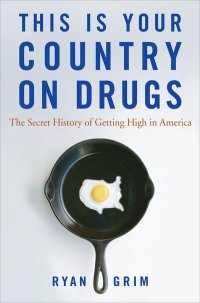Phillip S. Smith, Writer/Editor
"This Is Your Country on Drugs" is a welcome addition to the drug literature. With it, author Ryan Grim has produced an entertaining, enlightening, and accessible account of America's love-hate relationship with psychoactive substances ranging from the nation's beginnings to the present day.

From there, Grim is off to the races, taking the reader on a wide-ranging tour of America on drugs. Grim leaps from the LSD shortage of the '00s to the drinking habits of the antebellum years, the rise of the temperance movement, and the subsequent decline in alcohol consumption -- which, not surprisingly, was accompanied by the first wave of opium use in the mid-19th Century.
That should have been an early lesson about the unintended consequences of prohibitionist policies, but of course, it wasn't. Not only did altered consciousness-hungry Americans find a substitute for booze in opium pills and preparations at mid-century, but they did so again in the 1890s, as alcohol prohibition sentiment strengthened, setting the stage for the first "modern" drug "epidemics."
It is, as Grim demonstrates, a lesson that has been repeated over and over again, but remains unlearned. After the government cracked down on cocaine early last century, lo and behold, amphetamine use started taking off. After it cracked down on amphetamines around 1970, lo and behold, cocaine made a comeback. With the war on cocaine and declining social acceptability, what should pop up but methamphetamine?
Grim also untangles the unintended consequences of Nixonian and Reaganite anti-drug efforts, both of which helped lay the groundwork for the emergence of the Mexican drug trafficking organizations, the so-called cartels, which are so bloodily newsworthy these days. Nixon's attempted crackdown on Mexican marijuana nudged smugglers to shift to cocaine, and Reagan's crackdown on Caribbean cocaine trafficking into Miami merely shifted the smuggling routes from sea to land, from the Caribbean to Mexico. Less than 20 years after that, we confront on the border the Frankenstein's monster that is the cartels.
If there is any question about it, "This Is Your Country on Drugs" makes eminently clear that Americans like getting high -- and always have. Drawing on a wide variety of sources from primary documents to government drug warriors, Grim provides an episodic history of drug use in America that is going to be eye-opening for most readers, and even had a few surprises for the crusty old drug historian, yours truly. Who knew that opium imports were rising as alcohol consumption was declining in the 1830s?
"This Is Your Country on Drugs" is less a polemic than a social history, although Grim makes clear that he thinks prohibition is a waste of time. "Prohibition helps create the very conditions that make prohibition ineffective," he writes, explaining that the decentralized nature of drug markets makes snagging the little fish much, much easier than catching the big one.
The book is also up-to-the-minute. It covers the rise of medical marijuana, the "methedemic" of the 1990s (he notes, interestingly, that a good sign a drug "epidemic" is coming to an end is that the mass media breathlessly announces its beginning), and the rising popularity of salvia, ayahuasca, and other psychedelics this decade.
I fear I haven't done the book justice, haven't mentioned enough of what Grim covers. You will have to buy this book, read it yourself, and let me know. You're sure to learn something if you do.
This work by StoptheDrugWar.org is licensed under Creative Commons Attribution-ShareAlike 4.0 International
Add new comment